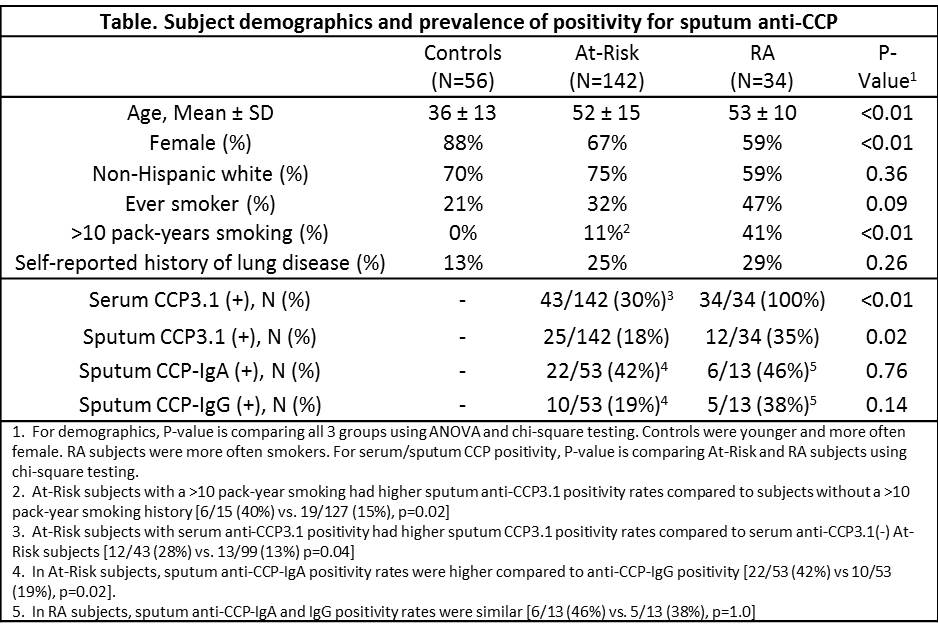Session Information
Date: Sunday, November 8, 2015
Title: Rheumatoid Arthritis - Human Etiology and Pathogenesis Poster I
Session Type: ACR Poster Session A
Session Time: 9:00AM-11:00AM
Background/Purpose: Serum elevations of anti-CCP prior to inflammatory arthritis (IA) in RA suggest that anti-CCP is generated at a site outside of the joints. Data suggest this site is likely a mucosal surface. To test the hypothesis that anti-CCP is generated in the lung mucosa, we examine levels of specific anti-CCP isotypes in the sputum of subjects at risk for future development of RA.
Methods: From the Studies of the Etiology of RA (SERA) we studied 34 serum anti-CCP3.1(+) patients with RA (2010 criteria), 142 subjects without IA but At-Risk for future RA based on serum CCP3.1 positivity (N=43) or family history of RA (N=99) and 56 serum CCP3.1(-) healthy controls. Simultaneously collected serum and induced sputum were tested by ELISA for anti-CCP3.1 (IgG/IgA Inova Diagnostics). Sputum from a subset of subjects was also tested for isotype-specific anti-CCP-IgA and CCP-IgG (Inova Diagnostics, research use only). For each CCP, sputum positivity was set based on levels present in <5% of controls.
Results: Sputum anti-CCP3.1 levels were elevated in RA and At-Risk subjects and highest in RA (Figure Panel A, p<0.01). In At-Risk subjects, 25/142 (18%) were sputum anti-CCP3.1(+) of whom 13 were serum CCP3.1(-) (Figure A). Furthermore, anti-CCP3.1/total IgG+IgA ratios were higher in sputum than serum (p<0.01) supporting local lung generation and not serum translocation. For CCP isotypes, sputum anti-CCP-IgA levels were elevated and similar between RA and At-Risk subjects (Figure B, p=0.66). In contrast, sputum anti-CCP-IgG levels were higher in RA than At-Risk subjects (Figure C, p=0.02). Also, At-Risk subjects had higher rates of sputum anti-CCP-IgA positivity compared to IgG (42 vs. 19%, p=0.02), while in RA sputum anti-CCP-IgA and IgG positivity was similar (46 vs. 38%, p=1.0). Finally, in At-Risk subjects, sputum anti-CCP3.1 positivity was not affected by age or sex, but subjects with serum CCP3.1(+) and >10 pack-years of smoking had higher rates of sputum CCP3.1 positivity (Table).
Conclusion: Sputum testing identifies anti-CCP generation in the lung in a portion of individuals At-Risk for RA. Furthermore, sputum anti-CCP-IgA are more prevalent than IgG in At-Risk subjects which is in contrast to anti-CCP-IgA and IgG positivity rates in established RA which are similar. These findings suggest that in some subjects, anti-CCP-IgA generation in the lung may be an important factor in early loss of tolerance. Moreover, the development of sputum anti-CCP-IgG may be an important aspect of transition to articular RA. Longitudinal studies are needed to explore factors (including smoking) that may directly influence the development of mucosal autoimmunity in RA.
To cite this abstract in AMA style:
Demoruelle K, Ho L, Weisman MH, Gan RW, Parish MC, Feser ML, Fleischer C, Mahler M, Seaman A, Norris JM, Holers VM, Deane KD. Immunoglobulin-a and Immunoglobulin-G Isotypes of Anti-CCP Antibodies Are Present in the Sputum of Subjects at Risk for Future Development of RA [abstract]. Arthritis Rheumatol. 2015; 67 (suppl 10). https://acrabstracts.org/abstract/immunoglobulin-a-and-immunoglobulin-g-isotypes-of-anti-ccp-antibodies-are-present-in-the-sputum-of-subjects-at-risk-for-future-development-of-ra/. Accessed .« Back to 2015 ACR/ARHP Annual Meeting
ACR Meeting Abstracts - https://acrabstracts.org/abstract/immunoglobulin-a-and-immunoglobulin-g-isotypes-of-anti-ccp-antibodies-are-present-in-the-sputum-of-subjects-at-risk-for-future-development-of-ra/


